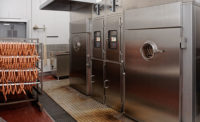Technologies for oven, fryers and smokehouses during the past few decades have been evolutionary, which explains many of the improvements the industry is seeing currently and is expected to see in the future.
For example, ovens years ago used burners inside the processing plant, which was a fire hazard. Today, processors use thermal fluids or remote heating outside the plant with no flame inside the oven. This change allows for much lower oxygen levels and much higher humidities. This improvement in technology also now allows processors to have a wider range of temperature, airflow, humidity, etc.
“While it is nice to have all that adjustment available, it’s really only as useful as you can reproduce it and understand what those things can do,” says Donald Burge, president of Applied Food Solutions LLC, in Sartell, Minn.
Now, training employees on thermal equipment and processing becomes key.
“The understanding and ability to utilize all of that range of adjustment that you have in an oven and frying system is the difference between an average processor and the best processors,” Burge says.
One of the specific advancements that has occurred is in the controllers of thermal processing equipment.
“One of the themes that we’ve seen in the equipment itself is the capability to store ‘recipes,’” Burge says.
For example, a processor could store a specific product’s recipe with the exact temperature, fan speed and humidity for a set period of time bundled together. Training and experience on the machinery is necessary to understand the best settings for that recipe’s variables, Burge says.
For smokehouses specifically, changes in airflow design, hybrid or stationary direction, and closed or open smoke systems can help reduce processing time, says Jonathan Campbell, extension meat specialist and associate professor in the Department of Animal Science at Pennsylvania State University, in University Park. “This can have economic and environmental impacts that are very positive for the processor,” he says.
Reduced smoking times also use less energy, which can reduce cost of production and increase throughput, he adds.
As computer technology advances, so does the technology available behind microprocessors and information that those microprocessors provide or could provide, Campbell adds. “Certainly, with the recent cyber attack on our fuel supply in the Southeast/Mid-Atlantic states, it would be prudent for meat processors to secure the technology for these microcomputers if they are online,” he says. “Also, robotics and automation, specifically for loading and unloading, may impact thermal processing as these technologies become more affordable and smaller scale for various sized meat processors.”
Along those lines, Burge agrees that an area to watch with ovens, fryers and smokehouses is adaptive technology. While not currently commercially available, equipment manufacturers are researching the engineering to detect attributes such as temperature and color and developing sensors that know when and how to react to changes. While smokehouses are still predominately used in a batch system, continuous smokehouse, oven and fryer lines where raw materials are fed into one end of the line at a continuous rate and cooked product comes out the other end offer many opportunities for feedback/feedforward technology. Ultimately, whole-line automation that also integrates into ovens, fryers and continuous smokehouses will be prevalent, Burge says.
Another advantage of an integrated thermal processing line would be the elimination of human error in running the line. For example, processors wouldn’t have to rely on employees taking temperatures. “People can be influenced and people can also make mistakes,” Burge says. “But to have undercooked product, it’s one strike and you’re done.”
“We are quite away from it, but that would be an absolute game changer,” he says.




Report Abusive Comment